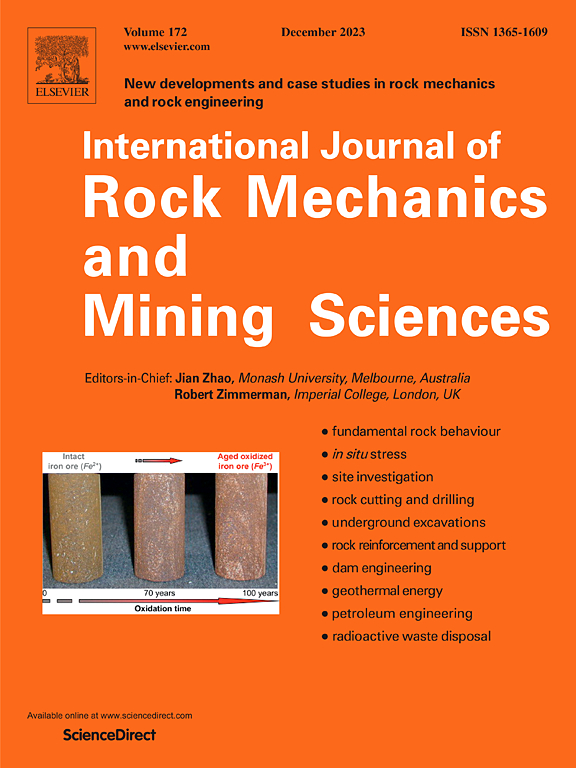A nonlinear inversion method for predicting the in-situ stress field in deep coal seam based on improved long short-term memory neural network
IF 7
1区 工程技术
Q1 ENGINEERING, GEOLOGICAL
International Journal of Rock Mechanics and Mining Sciences
Pub Date : 2025-02-01
DOI:10.1016/j.ijrmms.2024.106020
引用次数: 0
Abstract
Existence of discontinuous geological structures, such as folds and fault, poses a great challenge in predicting the in-situ stress fields (ISSF). This paper proposes a discontinuous intelligent inversion method to predict the ISSFs in the deep coal seam area (DCSA) of the Shanghai Temple, which exhibits distinct discontinuous geological features. The proposed method consists of three key components. First, a discontinuous loading model was developed to address the problem of accuracy in the numerical simulation of discontinuous tectonic regions such as folds and faults. The simulation data generated is used as a sample dataset for the training of the inversion algorithm and their completeness is fully guaranteed. Second, the statistical distribution patterns of horizontal, maximum and minimum lateral pressure coefficients (LPCs) of the ISSF in the typical DCSAs of China is statistically calculated. By applying Gaussian- and Cauchy-type fuzzy membership functions, the degree of influence of faults and folds on the local ISSF is quantified and the geological structure influence model is constructed. The influence value enriches the input data dimension of the algorithm and lays a more detailed data foundation for the stress inversion. Third, the improved Long Short-Term Memory (LSTM) network algorithm was constructed by optimizing the network hierarchy and multi-parameter cyclic learning. An inversion analysis is carried out using the ISSF around the borehole as an example, and the relative error strictly controlled within 1 %. The improved LSTM algorithm achieves an accuracy of 88.58 % at each measurement point in the Shanghai Temple deep coal seam project, which is significantly higher than that of the back propagation neural network (BPNN). The discontinuous intelligent inversion method proposed in this study can provide an effective tool for predicting the ISSF in DCSA.
基于改进长短期记忆神经网络的深部煤层地应力场非线性反演方法
褶皱、断裂等不连续地质构造的存在,给地应力场的预测带来了很大的挑战。本文提出了一种非连续智能反演方法,用于预测具有明显非连续地质特征的上海庙深部煤层区(DCSA)的issf。该方法由三个关键部分组成。首先,针对褶皱、断裂等非连续构造区域的数值模拟精度问题,建立了非连续加载模型;生成的仿真数据作为反演算法训练的样本数据集,其完整性得到充分保证。其次,统计计算了中国典型干旱地区ISSF水平、最大和最小侧压力系数的统计分布格局。利用高斯型和柯西型模糊隶属函数,量化了断层和褶皱对局部ISSF的影响程度,建立了地质构造影响模型。影响值丰富了算法的输入数据维度,为应力反演奠定了更详细的数据基础。第三,通过优化网络层次和多参数循环学习,构建改进的长短期记忆(LSTM)网络算法。以井眼周围ISSF为例进行反演分析,相对误差严格控制在1%以内。改进的LSTM算法在上海寺深煤层工程中,每个测点的精度达到了88.58%,显著高于反向传播神经网络(BPNN)。本文提出的不连续智能反演方法可为预测DCSA的ISSF提供有效工具。
本文章由计算机程序翻译,如有差异,请以英文原文为准。
求助全文
约1分钟内获得全文
求助全文
来源期刊
CiteScore
14.00
自引率
5.60%
发文量
196
审稿时长
18 weeks
期刊介绍:
The International Journal of Rock Mechanics and Mining Sciences focuses on original research, new developments, site measurements, and case studies within the fields of rock mechanics and rock engineering. Serving as an international platform, it showcases high-quality papers addressing rock mechanics and the application of its principles and techniques in mining and civil engineering projects situated on or within rock masses. These projects encompass a wide range, including slopes, open-pit mines, quarries, shafts, tunnels, caverns, underground mines, metro systems, dams, hydro-electric stations, geothermal energy, petroleum engineering, and radioactive waste disposal. The journal welcomes submissions on various topics, with particular interest in theoretical advancements, analytical and numerical methods, rock testing, site investigation, and case studies.

 求助内容:
求助内容: 应助结果提醒方式:
应助结果提醒方式:


